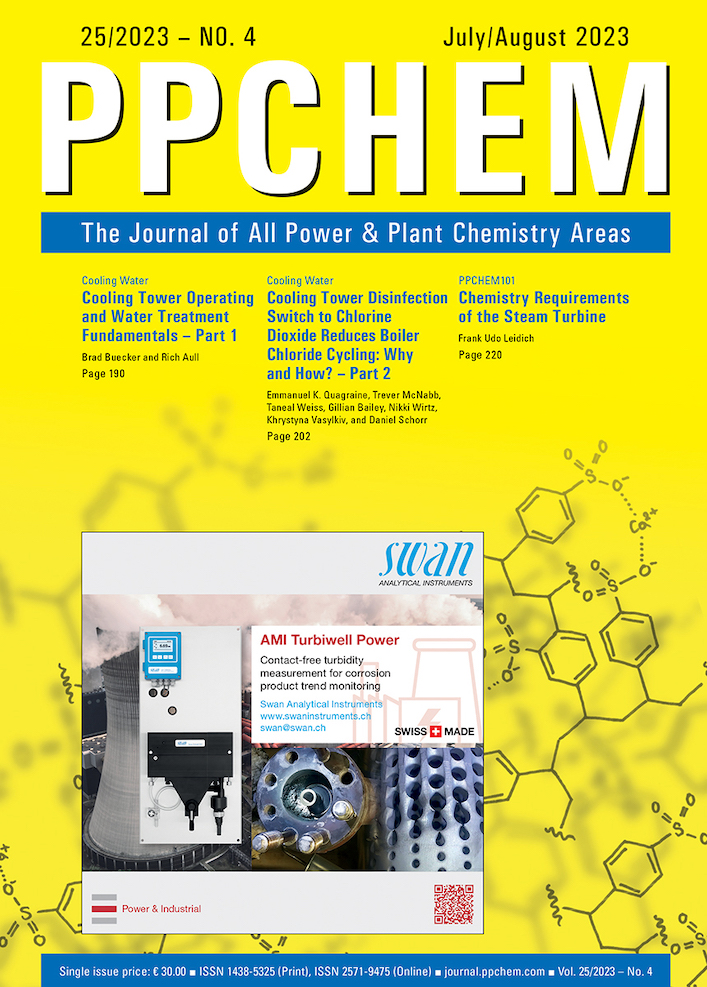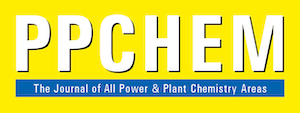
For members only
ABSTRACTS
Cooling Tower Operating and Water Treatment Fundamentals – Part 1
Brad Buecker and Rich Aull
Process cooling is an important operational factor in many industrial plants and commercial office buildings around the world. Most of these plants use cooling towers for primary cooling. A large facility may have dozens of towers scattered throughout the premises. Often, plant personnel are focused on process engineering and chemistry, potentially neglecting cooling systems until a serious disruption occurs that threatens plant production or, worse, jeopardizes employee safety.
This article forms the basis of a short series of articles dealing with the chemistry of cooling systems. In this first part of the series, we examine the fundamentals of heat transfer in the cooling tower and the methods that have been developed to improve heat exchange in the tower. Subsequent parts discuss modern water treatment methods to ensure reliable performance.
PPCHEM® 2023, 25(4), 190–198
For Members only
Cooling Tower Disinfection Switch to Chlorine Dioxide Reduces Boiler Chloride Cycling: Why and How? – Part 2
Emmanuel K. Quagraine, Trever McNabb, Taneal Weiss, Gillian Bailey, Nikki Wirtz, Khrystyna Vasylkiv, and Daniel Schorr
This is the second half of a two-part article discussing the abatement of selective boiler chloride cycling (SBCC) upon switching the recirculating cooling water (RCW) biocide from NaOCl to ClO2. The use of ClO2 treatment significantly reduces SBCC, with only sporadic spikes observed to a much lower extent. These spikes are found to be related to the plant’s operation, coinciding with sudden load drops and increased air injector flows. It is suggested that these spikes may be caused by small ClO2(g) residuals condensing at the air injector condenser and entering the feedwater, eventually reducing to chloride ions (Cl–) in the water/steam cycle. Unlike chlorination, ClO2 treatment prevents the formation and persistence of volatile chlorine compounds (VCCs), including ClO2(g). The residual ClO2 in the RCW that is responsible for the highest observed daily boiler chloride rise during ClO2 treatment is estimated to be 4.05–9.74 ⋅ 10–5 mg ⋅ L–1. However, this concentration range represents only 0.02–0.23 % of the highest to the least measured residual concentrations, confirming the previous assertions that maintenance of substantial residual ClO2 in RCW, especially when using treated municipal wastewater as make-up, is unlikely. Overall, the operational data supports the switch from NaOCl to ClO2 as an effective method for reducing SBCC in the water/steam cycle, with ClO2 treatment showing superior performance and minimal VCC formation compared to NaOCl.
PPCHEM® 2023, 25(4), 202–210
For Members only
Chemistry Requirements of the Steam Turbine
Frank Udo Leidich
Safe and trouble-free operation of a steam turbine requires monitoring and control of the operating medium “steam.” In particular, it is necessary to prevent impurities in steam from causing corrosion attacks on turbine components, which, depending on the form of corrosion, can lead to sudden, unpredictable component failure. This PPCHEM 101 describes typical damage and failures that will eventually occur if the quality of the water and steam does not meet the requirements as stated in the operation manual of the steam turbine manufacturer and/or global standards and technical guidance documents as released by, for example, the International Association for the Properties of Water and Steam (IAPWS).
PPCHEM® 2023, 25(4), 220–226
For Members only
ERRATA
Nobody is perfect and everybody makes mistakes sometimes. We apologize to the authors and to our readers for the mistakes in the article:
Effect of Zinc Water Chemistry on the Corrosion and Stress Corrosion Cracking Behavior of Structural Materials in Light Water Reactors – A Review
Xianglong Guo, Kai Chen, Hans-Peter Seifert, and Stefan Ritter
PPCHEM® 2023, 25(3), 124–147

